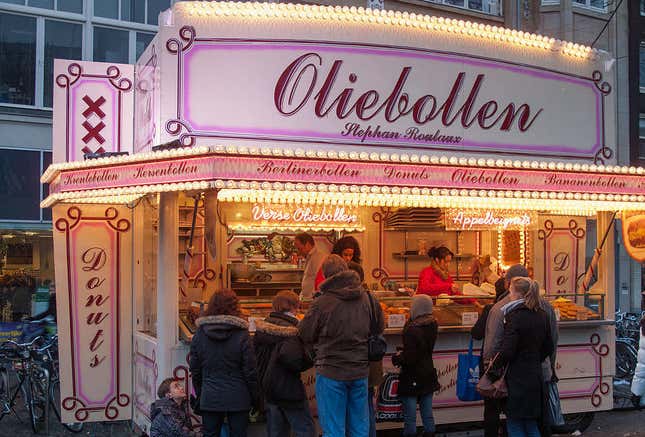
They don’t have pink frosting or rainbow sprinkles, but Dutch oliebollen are the precursor to American doughnuts. Back when New York was New Amsterdam, Dutch immigrants brought these dunkable delicacies to our shores. And while Americans devour doughnuts daily, the Dutch treats, translated as oil balls, are primarily available around New Year’s.
These fried dough spheres are believed to have originated over a millennium ago but didn’t come into written history until the 17th century. Rather than being ring-shaped, as the name suggests they’re the size of impressionist golf balls. (If you think “oil balls” isn’t a great name, consider smoutebollen, or lard balls, enjoyed just to the south in Belgium.) Oliebollen are not perfectly spherical, though: while they’re soft and spongy inside, errant strands of batter form browned, crispy protuberances like crunchy bow-ties. You could even say they’re dough knots.
That New Year’s window, much to the delight of those with a sweet tooth around the Netherlands, lasts roughly from October to February. But unlike with pumpkin spice lattes, no one complains about seasonal creep when they see the ubiquitous, tricked-out RVs and other pop-up stalls setting up around train or ferry stations, city squares, Christmas markets, or anywhere with large gatherings.

An oliebol (in the singular) consists of a simple mixture of flour, egg, milk or buttermilk, some salt, baking powder, and yeast. Its sweetness is derived from the baggie of powdered sugar that’s delivered with each purchase so that the customer administers his or her preferred amount. That said, oliebollen are frequently adorned with currants, apples, or raisins, but sometimes the Dutch go nuts with rum-soaked raisins, baked bananas, chopped nuts, or almond paste. Don’t look for them with maple frosting and candied bacon or rainbow breakfast cereal, since, again, these are the forebearers of American doughnuts but have not been Americanized.
There’s a shop in Tustin, California called Oliboli Donuts that makes oliebollen year-round. Founded by the Des Prez family, manager Hailey Des Prez says there’s no Dutch blood in her family, but her mother, chef Brook Des Prez says, “We sell [oliebollen] all year round. We’ll have some very upset customers if we try and take them off of the menu.” Oliboli Donuts proffers a range of European-inspired doughnuts including lebkuchen (Germanic gingerbread), banoffee (English banana cream pie), and croque madame (a savory doughnut made with prosciutto, gruyere, and a fried egg a la the French café staple). But the signature oliebol is made using a 40-hour yeasted dough, apples, currants, raisins, lemon peel, and spices.
Brooke adds that the emotional connection that some customers have with this doughnut is so strong, “We have had a few brought to tears as they were eating them.”
As mentioned, oliebollen stands vend the wintry morsels starting in autumn, but no New Year’s party is complete without them; typically guests enjoy an oliebol in one hand and a flute of champagne in the other while fireworks erupt all around. (As an American who has rung in the New Year in Amsterdam, I assure you that’s no exaggeration: the Dutch ring in the new year with twice the fervor of our Fourth of July celebrations, and seemingly every household sets off an arsenal of explosives.) But when the fireworks are over, the warm, comforting embrace of oliebollen sticks around for at least another few weeks.